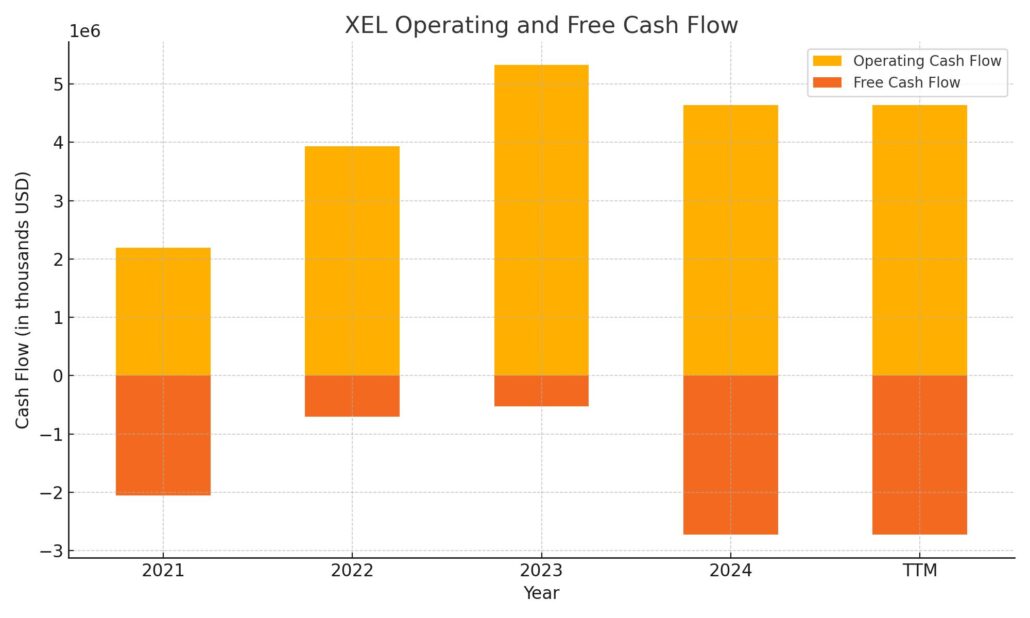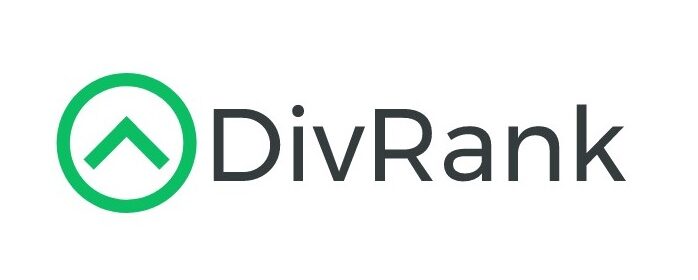Updated April 2025
Based in Minneapolis, Xcel serves millions of electric and natural gas customers across eight states. It’s a classic regulated utility, which means it operates with a predictable stream of income and a structure that supports stable, recurring payouts to shareholders. What sets Xcel apart is its clear focus on the future. The company has been leaning hard into clean energy investments—something that not only aligns with policy shifts but also fuels a steady expansion of its regulated asset base. For dividend investors looking for consistency over flash, this is where Xcel quietly shines.
🔔 Recent Events
In the last year, XEL’s stock has climbed over 31%, comfortably beating the broader market. For a utility stock—often thought of as slow and steady—that’s no small feat. The surge isn’t random. It’s backed by a combination of solid financial performance, long-term strategy execution, and investor confidence in Xcel’s path forward.
The company is continuing its aggressive push to cut carbon emissions, with plans to slash emissions by 85% and phase out coal by 2030. These goals aren’t just lofty—they’re part of a tightly regulated plan, which gives investors a clear line of sight into future earnings and cash flow.
Most recently, Xcel declared a dividend of $0.57 per share, to be paid on April 20, 2025. The move keeps them on track with their long-standing history of consistent raises, and for shareholders, that’s yet another reliable income check right on schedule.
📊 Key Dividend Metrics
💰 Forward Dividend Yield: 3.22%
📈 5-Year Average Yield: 2.96%
📆 Ex-Dividend Date: March 14, 2025
📅 Next Payment Date: April 20, 2025
🔁 Payout Ratio: 63.66%
🚀 Dividend Growth: Modest, consistent year-over-year increases
🧾 Free Cash Flow Coverage: Negative currently, due to infrastructure investment
🧱 Dividend Stability: High, with support from regulated cash flows
💸 Dividend Overview
Xcel’s dividend isn’t going to make headlines, but it’s dependable, consistent, and right in the comfort zone for long-term income seekers. The current forward yield of 3.22% sits above its five-year average, offering a little extra cushion for new investors stepping in today. It’s not sky-high, but it doesn’t need to be when the payout is this reliable.
At a payout ratio just shy of 64%, the company leaves itself enough room to both reward shareholders and invest heavily in its energy transition strategy. That’s a balancing act, and Xcel has been walking it successfully. Its business structure—anchored by regulated utility operations—makes that possible. Predictable earnings are the bedrock here, and they allow the company to return capital to investors while still planning decades ahead.
The stock’s low beta of 0.40 is another draw for those looking to lower portfolio volatility. Xcel isn’t likely to soar on news or drop on headlines—but that’s exactly why it works so well in an income strategy. For many dividend investors, slow and steady is the name of the game.
🌱 Dividend Growth and Safety
Dividend growth is where Xcel’s discipline really comes into focus. Over the last few years, the company has quietly bumped its payout higher on a consistent annual schedule. The latest increase took the quarterly dividend to $0.57 per share—a clear message that management remains committed to long-term income investors.
The growth may not be flashy, but it’s sustainable. It’s also tied directly to earnings growth, which helps keep the payout ratio from creeping into dangerous territory. That steady link between business performance and dividend policy is a big part of why income-focused investors stick around.
Now, about dividend safety.
At first glance, the negative free cash flow might raise eyebrows. But in Xcel’s case, it’s tied to planned capital expenditures in clean energy infrastructure—a key part of the company’s long-term growth. This isn’t a sign of financial trouble; it’s the nature of regulated utilities investing ahead of rate base growth. Regulators allow companies like Xcel to earn returns on these investments, which means today’s spending lays the foundation for tomorrow’s earnings.
Debt levels are on the higher side, with a debt-to-equity ratio around 155%. Again, in the utility world, that’s not out of the ordinary. These businesses operate with high leverage because of their regulated, predictable cash flows. Xcel has shown it can manage that leverage responsibly, with earnings and EBITDA figures that provide plenty of coverage.
Ownership trends paint a clear picture of confidence. Institutions hold a hefty 88% of the stock, signaling strong interest from professional investors who value income stability and a clear earnings roadmap. Insider ownership is low, but that’s typical for a large-cap utility.
In short, Xcel doesn’t chase trends—it delivers. For dividend investors, that’s often exactly what you want. A company with a clear path, a commitment to steady payouts, and a business model that can weather both economic shifts and market cycles.
Cash Flow Statement
Xcel Energy’s cash flow picture over the trailing twelve months shows a familiar pattern for capital-intensive utilities. Operating cash flow came in at $4.64 billion, a solid figure that demonstrates the underlying strength of the company’s regulated earnings base. However, that cash generation isn’t enough to fully cover the company’s aggressive investment activity, with capital expenditures reaching $7.36 billion, resulting in a negative free cash flow of $2.72 billion. This negative figure isn’t out of the ordinary for a utility in growth mode, especially one actively building out renewable infrastructure that will be rate-based over time.

On the financing side, the company pulled in $2.84 billion—mostly through debt issuance—which helped support its ongoing capital needs and dividend commitments. Interest expense continues to tick up, landing at $1.13 billion, reflecting both rising debt levels and a higher rate environment. Despite the heavy spending, Xcel managed to slightly increase its cash on hand to $179 million. While the free cash flow shortfall might seem like a red flag in other sectors, for a regulated utility like Xcel, it reflects planned investment into long-term growth, with the expectation that those investments will translate into future earnings and shareholder returns.
Analyst Ratings
📊 Xcel Energy (XEL) has recently drawn fresh attention from analysts, with a noticeable lean toward positive sentiment. As of early April 2025, the stock holds a “Moderate Buy” consensus from analysts, with 8 recommending a buy and 2 suggesting a hold. The average price target sits at $73.00, with estimates ranging between $59.00 and $80.00. That gives XEL a bit of upside from its current trading range and reflects steady confidence in its forward outlook.
📈 Back in December 2024, JPMorgan Chase upgraded the stock from “Neutral” to “Overweight” and raised their target from $69.00 to $80.00. Their shift came down to Xcel’s momentum in clean energy initiatives and infrastructure upgrades—both areas that align well with long-term regulatory trends. The firm’s ability to fund and execute large-scale projects without disrupting dividend payouts likely played a role in the call.
🚀 Wells Fargo followed suit in January 2025, upgrading their stance from “Equal-Weight” to “Overweight” and nudging their price target up to $75.00. The move reflected growing confidence in Xcel’s consistent financials and the defensive strength of its regulated business model. These types of upgrades tend to stick when tied to long-term visibility.
📉 Not everyone was quite as bullish, though. Barclays maintained their “Overweight” rating in the same month but slightly trimmed their price target from $71.00 to $69.00. The adjustment reflected concern over potential regulatory delays or rate-setting headwinds that could cap earnings growth in the near term.
🧭 Despite the mixed views, the overall trend in analyst sentiment leans positive, suggesting a stable base with room for upside—especially if execution on long-term projects continues smoothly.
Earnings Report Summary
Solid Annual Results with a Focus on the Long Game
Xcel Energy wrapped up 2024 on a solid note, delivering earnings growth that aligned well with expectations. The company posted GAAP earnings of $3.44 per share, a decent step up from $3.21 the year before. If you strip out the one-time stuff, their ongoing earnings came in at $3.50, which speaks to the underlying strength of their business. That kind of consistency is what investors typically look for in a utility stock.
What helped move the numbers? Primarily, stronger recovery of investments tied to infrastructure projects. These are long-term, regulated returns that slowly build value over time. That said, it wasn’t all smooth sailing. Xcel had to navigate higher depreciation and rising interest costs—pretty standard headwinds for a capital-heavy operation. Operating and maintenance expenses also nudged higher, which took a bit of the shine off the top-line performance.
Fourth Quarter Came In a Bit Light
The last quarter of the year wasn’t quite as strong. Earnings per share landed at $0.81, which was a bit shy of expectations. Revenue came in at $3.12 billion for the quarter, down from $3.44 billion in Q4 of the prior year. Most of that drop came from lower electric fuel costs and reduced volumes in the natural gas segment. Not a huge surprise given the mild weather in parts of their service areas, but still worth noting.
Staying the Course for 2025
Despite the softer quarter, Xcel isn’t changing its outlook. They’re guiding for earnings between $3.75 and $3.85 per share for 2025, showing confidence in their ability to keep things steady. More interesting, though, is their long-range investment plan. The company is looking to spend around $45 billion through 2029—mostly going into grid modernization and expanding renewable capacity. It’s a bold but strategic move that aligns with where the industry is heading.
Customer Growth and Market Trends
On the operational side, they saw a 1.2% increase in electric customers and a 0.9% rise in gas customers, which adds some underlying strength to the story. Electric volumes were up slightly, but natural gas volumes dipped a bit, likely due to weather and pricing. Nothing alarming there—just part of the seasonal ebb and flow that comes with the territory.
All in all, it’s a report that shows a company staying on track, keeping its focus on long-term growth while managing the short-term bumps with the kind of discipline you’d expect from a utility like Xcel.
Chart Analysis

Price Trend and Moving Averages
The chart for XEL over the past year paints a clear picture of a stock that’s gained meaningful traction. Starting near the $50 range, the price has pushed steadily higher, recently touching levels just above $72. What’s especially encouraging is how the 50-day moving average (shown in red) crossed above the 200-day moving average (in blue) around late August. That golden cross is often seen as a bullish indicator, and in this case, it clearly aligned with a strong upward price move.
Since then, both moving averages have trended upward in tandem, showing a healthy and sustained advance. The price consistently riding above both moving averages suggests strength in momentum and a well-supported rally. There’s no sign yet of that momentum breaking down, as the most recent candles show the price still holding comfortably above the 50-day line.
Volume and Market Participation
Looking at the volume panel, there’s a noticeable pickup in activity during key breakout phases, especially in late summer and again in early March. Those surges coincide with price spikes, indicating strong participation during upward moves. Volume has cooled off slightly in recent weeks, but nothing suggests weakness—more like consolidation after an extended run.
The balance of red and green bars also points to healthy price action. No extended periods of selling pressure are visible, which gives more credibility to the strength behind the climb.
Relative Strength Index (RSI)
The RSI in the bottom panel has mostly hovered between 50 and 70 since the summer rally began. It briefly touched overbought territory above 70 a few times—most notably in March—but never stayed there too long. That kind of behavior shows strong buying interest without entering overheated conditions for long. Currently, RSI is sitting just under 70, suggesting momentum is still in play but not overly stretched.
Taken altogether, XEL appears to be in a mature uptrend, supported by both moving averages and constructive RSI action. The overall tone of this chart reflects steady accumulation and growing confidence in the stock’s long-term trajectory.
Management Team
Xcel Energy is led by a seasoned group of executives with a clear focus on innovation, reliability, and long-term strategy. At the top is Bob Frenzel, who serves as Chairman, President, and CEO. His leadership has been central to pushing Xcel’s clean energy transition forward, with a long-term view that aligns both with policy trends and investor expectations.
Supporting him is Rob Berntsen, Executive Vice President and Chief Legal and Compliance Officer. He plays a key role in guiding the company through the complexities of regulatory environments, which is critical for a multi-state utility. Brian Van Abel, Executive Vice President and Chief Financial Officer, brings discipline and foresight to Xcel’s financial planning, helping manage capital allocation while supporting growth initiatives.
Together, this team blends operational know-how with strategic vision. Their combined experience across legal, financial, and technical areas creates a strong foundation for executing on the company’s ambitious long-term plans.
Valuation and Stock Performance
Xcel Energy’s stock (XEL) has shown steady growth over the past five years, rising approximately 17 percent over that time. While not a high-flying performer, its consistency stands out—especially in an environment where volatility remains elevated across many sectors.
Looking at valuation, XEL trades at a price-to-earnings ratio that’s in line with utility industry norms. It’s neither aggressively priced nor overly discounted, suggesting the market views it as a stable, fairly valued company. The stock’s beta, sitting at just under 0.40, reinforces its reputation as a lower-volatility play, which is typical for regulated utilities.
Analyst coverage generally reflects cautious optimism. A number of recent revisions have modestly raised price targets into the mid-to-upper $70s, which lines up with the company’s continued investment in renewables and infrastructure. That forward-looking capital spend seems to be priced into the stock, but without any excessive valuation risk.
Overall, XEL’s market performance mirrors the kind of reliable execution and modest capital appreciation many investors look for in the utility space.
Risks and Considerations
Despite its strengths, Xcel Energy does face some real-world challenges. Regulatory risk is always present in the utility industry, and with Xcel operating across multiple states, changes in rate policies or compliance standards could directly impact earnings.
Environmental risk is another factor. Past incidents, like the Monticello nuclear plant leak, have shown that even a well-run operation isn’t immune to operational hiccups. These types of events can carry not just cost implications but also reputational concerns. The company has taken steps to address these risks, but they remain part of the landscape.
Extreme weather events are another consideration, particularly in service regions prone to drought, wildfires, or high wind activity. As climate patterns shift, Xcel will need to continue reinforcing the grid and upgrading infrastructure to maintain reliability.
None of these risks are unique to Xcel, but they do underscore the importance of proactive management and long-term planning—both of which the company appears to be prioritizing.
Final Thoughts
Xcel Energy remains one of the more compelling names in the utility space for its ability to balance tradition with forward-thinking investment. It offers the kind of stable operating profile that many investors look for, while also being one of the more progressive utilities when it comes to renewables and carbon reduction.
The management team has laid out a clear path for the future and is executing steadily. The valuation reflects its fundamentals—reasonably priced without being stretched. Risks exist, as they do with any utility, but Xcel’s infrastructure upgrades and regulatory alignment put it in a strong position to manage those risks effectively.
It’s a company quietly doing the right things, focusing on long-term gains, and delivering consistent results. For investors looking for a business with staying power and a steady hand at the wheel, XEL continues to earn its place on the radar.

